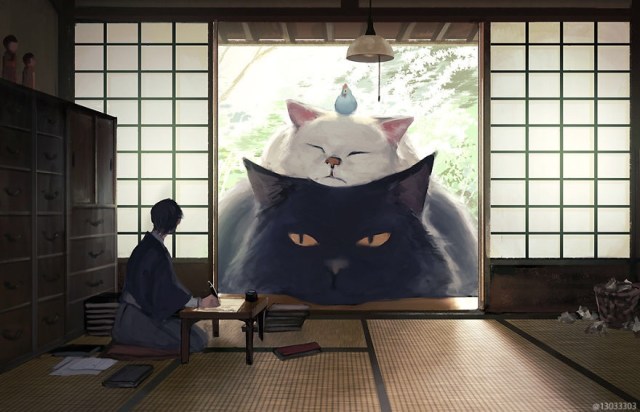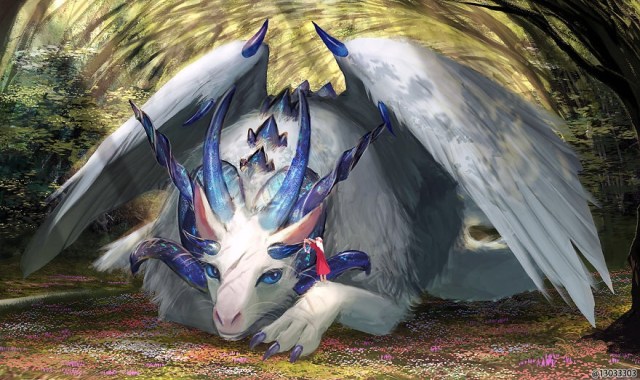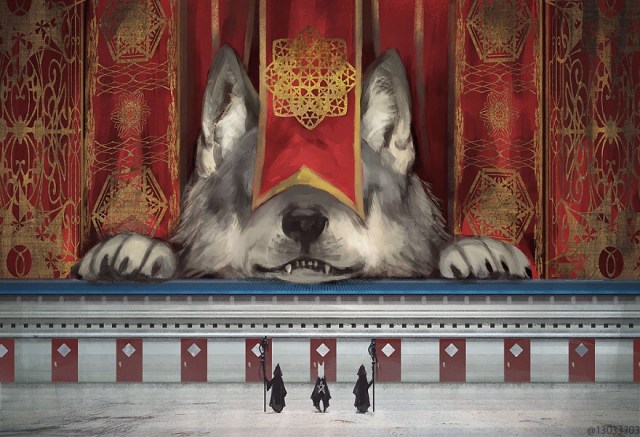Ariduka55: the japanese illustrator and his world where humans live among giant animals.
6 min read
A super creative mysterious illustrator from Japan, imagines the world like no other. On social media, the artist is known as Ariduka55, or Monokubo, and it seems artist loves cats the most, even if there are a lot of other cuddly animals like pandas, rabbits, raccoons and others, and they are all giant creatures!
“A world where you can surrender yourself to sleep on a giant ball of fur is a world where you wouldn’t be able to get any work done. A perfect world.”
In this world people are tiny and animals are big as three storey building. It is a world where a cat can get sad and cry, and pick up her little human to hug it for comfort. The atmosphere is mostly peaceful or especially moody. Sunshine often streams through the trees and other elements representing everyday beauty. Many of the illustrations are marked with soft sunshine filtering through various objects, including leaves and windows. The Japanese even have a word for sunlight streaming through the leaves of the trees – komorebi (木漏れ日). It’s a term for a light curtain and the shadow it creates on the ground, that eloquently describes this everyday beauty.
Unlike in Western world culture (although a museum dedicated to them will soon be open in Naples, Italy), in Japan seeing a black cat crossing your path is considered to be a good omen. Therefore many black cats seen in Ariduka55’s illustrations are a symbol of good luck.

“In Japanese mythology, grain farmers once worshipped wolves at shrines and left food offerings near their dens, beseeching them to protect their crops from wild boars and deer. Talismans and charms adorned with images of wolves were thought to protect against fire, disease, and other calamities and brought fertility to agrarian communities and to couples hoping to have children. The Ainu people believed that they were born from the union of a wolf like creature and a goddess.”
The Lost Wolves Of Japan (Brett L. Walker, 2005)

In this image a girl comes back home and uses a HUG card on her cat, but this non-exploding kitten combats the girl’s futile attempt at physical contact with a NOPE card of his own.
The Japanese have a daily expression “tadaima” (ただいま) which is a shortened version of “I just came home”, and while usually it is polite to respond with “okaeri” (おかえり) i.e. “welcome home”, this giant feline will have none of it!

A world where you can surrender yourself to sleep on a giant ball of fur is a world where you wouldn’t be able to get any work done. A perfect world.
Fun fact: in traditional Japanese architecture, a door, window or room divider made of translucent paper over a frame of wood is called shōji. It probably all comes down to the Japanese love for minimalism, for the purpose of shōji doors is to slide open, and thus conserve space that would be otherwise required for a swinging door.

A tranquil and slightly gloomy part of the series featuring a Korean crow-tit (Baepsae). There is a common idiom/saying: “the crow tit will break its legs trying to walk like a stork”, which means pretending to be something you are not.

A peaceful autumn afternoon at the shrine saturated with both color and falling leaves. The animal depicted in this particular illustration is not a regular raccoon, but it is a Tanuki (or a raccoon dog), an atypical species of dog that can grow up to 60 cm in length, with distinctive stripes of black fur under its eyes. Unlike a raccoon, tanuki has a roundish nose, small floppy ears, short and furred paws for running, and a tail that is not ringed. Originally an evil trickster and spook in Japanese folklore, Tanuki is now a benevolent modern-day symbol of generosity, cheer and prosperity.

The fox plays a role in Japanese culture that’s unusually rich and complicated. Beliefs that developed when people lived much closer to nature persist in stories, festivals, and language. Even in these rational times, the fox has a magical aura that still lingers. The fox is associated with Inari as a symbol, a messenger, a servant, or maybe more. Inari is the Japanese god of foxes, of fertility, rice, tea and sake, of agriculture and industry, of general prosperity and worldly success, and one of the principal gods of Shinto.
Foxes are one of the most revered animals in the Japanese tradition and folklore. Kitsune (狐 or きつね) is a Japanese word for ‘fox’, and stories depict them as intelligent beings with supernatural powers. According to Yōkai folklore (did you know that a dedicated museum has recently opened in Japan?), kitsune has the ability to shapeshift into a human form. While some folktales speak of kitsune employing this ability to trick others, as foxes in folklore often do, other stories portray them as faithful guardians, friends, lovers, and wives.


One of the more famous elements in Asian folklore is the Moon rabbit. It’s a myth based on pareidolia that identifies the markings of the Moon as a rabbit. Although it originated in China, the myth eventually spread to other Asian cultures as well. A curiosity: the name of the popular character Sailor Moon by Naoko Takeuchi is actually Tsukino Usagi which means ‘the rabbit of the moon’!

Japan perceives the butterfly to be a “soul of the living and the dead”, as a result of the popular belief that spirits of the dead take the form of a butterfly when on their journey to the other world and eternal life. The butterfly is also often used as a symbol for young girls as they spread their wings and emerge into womanhood, as well as it being believed to symbolise joy and longevity.

This “hill” is Shiba Inu breed, that is Japan’s one of the most cherished treasures. Literally meaning ‘the brushwood dog’ these dogs were traditionally used for hunting small animals, and nowadays, Shiba Inus are very popular in pop-culture.

Historically, cats have been revered in many societies, and particularly in the Japanese culture they are highly regarded as symbols of good luck. The popular Japanese cat figurine maneki-neko (招き猫, ‘beckoning cat’) is typically believed to bring about blessings. The figurine is often of a cat with its paw in an upright position as if beckoning. According to Japanese legend, a landlord witnessed a cat waving a paw at him. Intrigued by this gesture, he came close to the cat when suddenly a lightning bolt struck the exact place he was previously standing in. The landlord believed that his good fortune was because of the cat’s actions. Hence, the beckoning hand became a symbol of good luck.

It’s not unusual for the Japanese to carry an owl charm with them, because just like cats, owls are the symbols of good luck, who also offer protection from suffering. In different parts of the country, they have also historically been given a variety of other attributions, for example, the guiding bird or a bird which can predict the weather.

Also Inoshishi (the boar) is part of the Japanese culture and mythology. It is one of the 12 Chinese zodiac symbols and in the past, the boar was called yamakujira, meaning “the whale of the mountains.” It is still considered a dangerous animal, that sometimes attacks people and damages crops. It appears in the Japanese folklore, as the boar gods in “Princess Mononoke” or as Inosasao, the boar with the back covered in bamboo leaves.

















Sources and References: Ariduka55 on Tumblr , BoredPanda.






